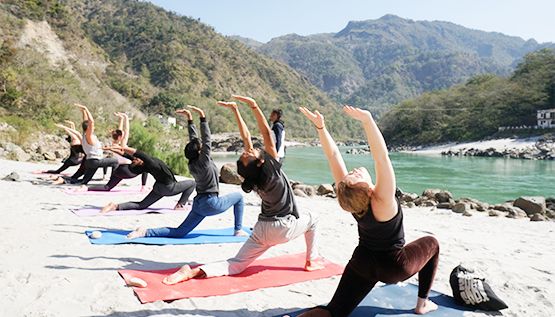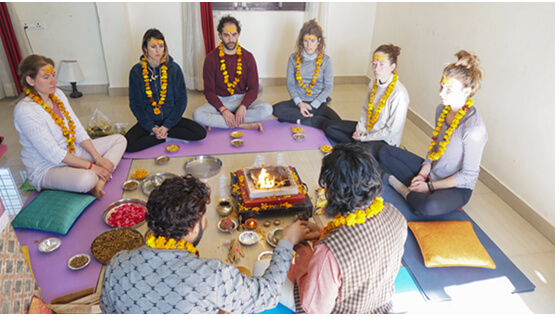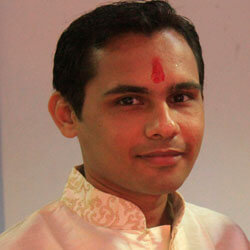Ayurveda Meets Yoga: Advanced 500-Hour Teacher Training in Rishikesh for True Wellness.
– Acharya Siddhant500-Hour Yoga Teacher Training with Ayurveda in Rishikesh
Siddhant School of Yoga presents a 500-hour Yoga Teacher Training Course in Rishikesh approved by Yoga Alliance USA. The 500-hours Yoga and Ayurveda Teacher Training Course in Rishikesh is a complete, advanced program that combines the syllabus of a 200-hour and 300-hour Teacher Training course. It is aimed for serious practitioners and aspiring teachers who want to deepen their understanding of yoga asanas like Hatha Yoga, philosophy, Meditation, Mantra Chanting, Ayurveda anatomy & Physiology, and the holistic ethics values of Ayurveda offering a complete transformation of your body, mind, and consciousness.
A 500-hour Yoga and Ayurveda Teacher Training Course in Rishikesh is the most important part in your individual and professional development. It’s an opportunity to connect with the authentic heritages of these ancient Yoga and Ayurveda practices, learn from experienced teachers, and truly transform your life purpose. You will not only get just a certification, but also with a deeper sense of self, a balanced lifestyle, and the assurance to guide others on the path to holistic and wellness life journey.
Why Siddhant School of Yoga for Yoga and Ayurveda Course?
Siddhant School of Yoga offers specialised 500 hours integrated holistic yoga and Ayurveda Teacher Training that deeply integrated with principles with modern and result oriented practices. The following points is the core concept of our Yoga and Ayurveda course that helps students and seekers deep dive with integrated holistic approach with transformative experience.
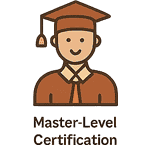
Siddhant School of Yoga’s 500-hour Yoga and Ayurved Teacher Training Course helps you a globally recognized Yoga Teacher. This master level course combine with 200 hours foundational training and 300 hours advanced Yoga and Ayurveda Training under the experts Yoga Teacher guidance. This is vision to provide best yoga and Ayurveda education to the passionate students to establish them on global platform.
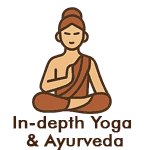
Our 500-hour Yoga Teacher Training course in Rishikesh provides a complete curriculum covering subjects such as Hatha Yoga, Ashtanga Vinyasa, Pranayama, Bandha, Mudra, Mantra Chanting, Meditation, Anatomy & Physiology, Yoga Nidra, Ayurveda, Yoga Philosophy, and many more — from the foundational level to advanced practices. After completing the course, you will also learn how to teach effectively and gain practical experience by teaching other students during the final phase of the training to build confidence.
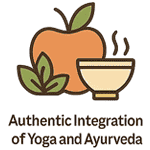
A key differentiator for Siddhant School of Yoga is our integrated approach. The course includes a deep dive into Ayurvedic principles, from an Ayurvedic diet and daily lifestyle rituals to cleansing practices. This fusion of yoga and Ayurveda provides a comprehensive understanding of mind-body wellness, empowering you to become a holistic yoga teacher who can guide students toward true balance and health.
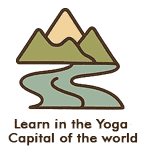
Experience your 500-hour yoga and Ayurveda TTC in the spiritual environment of Rishikesh, the world-renowned birthplace of yoga. The serene and sacred setting on the banks of the Ganges River enriches your yogic learning and helps you form a deeper spiritual connection. This immersive experience is essential for any student looking for authentic yogic teachings passed down through generations

At Siddhant School of Yoga, we prioritize your individual growth. Our courses are led by highly qualified and experienced yoga gurus and therapists who offer personalized guidance and mentorship. With a small group of 10-15 students, we ensure you receive the personal attention needed for your proper growth and transformation, aligning with the traditional Gurukul teaching style.
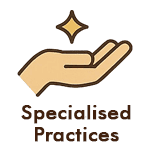
Siddhant School of Yoga goes beyond the basics by including specialized practices like Mantra Science and Kundalini & Chakra Meditation. These unique sessions are designed to elevate your energy and awaken higher consciousness. From an Ayurvedic perspective, these practices help to clear blockages in the energy channels (nadis), promoting a profound state of inner balance and well-being.

We help you track your progress by providing clear parameters to measure your growth—a unique offering in the world of yoga education. Our course is designed for both personal transformation and professional development. You'll leave as a confident and skilled registered yoga teacher (RYT 500), prepared to teach diverse groups and pursue a successful career anywhere in the world.

One of the biggest challenges in yoga teacher training programs is overcrowded classes, where students struggle to get personal attention. At Siddhant School of Yoga, we solve this by maintaining small batch sizes of only 10–15 students per 500-hour Yoga & Ayurveda TTC.

Siddhant School of Yoga is one of the first schools in Rishikesh to provide students with "symptoms and parameters" to measure your growth throughout the course. This unique, results-oriented approach helps you track your progress in physical health, mental balance, and intellectual understanding. By making your growth tangible, the school empowers you to take ownership of your journey and develop into a confident and effective professional yoga instructor.
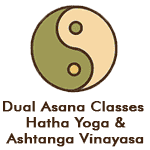
Siddhant School of Yoga provides in-depth training in two of the most popular yoga styles: Hatha Yoga and Ashtanga Vinyasa. This dual-style expertise makes you a highly versatile and knowledgeable instructor. You'll master the foundational postures of Hatha, which provide stability and strength, while also learning the dynamic flows of Ashtanga Vinyasa to build stamina and a rhythmic, flowing practice. This combination prepares you to teach a wide range of students, from beginners to advanced practitioners.
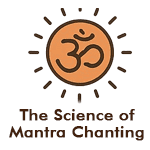
A unique component of the curriculum is Mantra Science, which teaches the transformative power of sound energy. In this course, you will learn the correct pronunciation and meaning of traditional mantras. From an Ayurvedic perspective, mantra chanting is a powerful tool for calming the nervous system, balancing the doshas, and clearing mental congestion. This practice not only enriches your personal life but also provides a valuable skill to incorporate into your classes to help students find inner stillness and focus.

To truly immerse yourself in the yogic lifestyle, Siddhant School of Yoga offers a supportive residential setup that creates a family-like environment. You will live and learn with a small, close-knit community of like-minded students and teachers. This setting fosters a sense of belonging and enables you to fully focus on your personal and professional growth without the distractions of daily life. The nutritious, Ayurvedic diet and a positive atmosphere all contribute to a transformative and holistic experience.
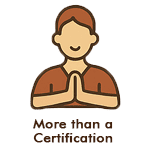
While committed to preparing you as a Yoga Alliance RYT 500 certified teacher, Siddhant School of Yoga emphasizes that yoga is a path for inner growth, not just a profession. The comprehensive 500-hour Yoga & Ayurveda TTC curriculum is designed to help you redesign your subconscious mind, find a deep sense of purpose, and develop the qualities of a great teacher: commitment, compassion, and true knowledge. This makes the program a truly life-changing and transformative experience
500 Hour Yoga & Ayurveda Teacher Training in Rishikesh
Upcoming Dates & Fees
| Course Date | Triple Sharing | Shared Room | Private Room | Apply Now |
|---|---|---|---|---|
| 03-01-2026 to 28-02-2026 | USD 2199 | USD 2699 | USD 2999 | Booking Open |
| 03-03-2026 to 28-04-2026 | USD 2199 | USD 2699 | USD 2999 | Booking Open |
| 03-05-2026 to 28-06-2026 | USD 2199 | USD 2699 | USD 2999 | Booking Open |
| 03-07-2026 to 28-08-2026 | USD 2199 | USD 2699 | USD 2999 | Booking Open |
🕉️ Ready to master your yoga& Ayurveda teaching?
Take your yogic journey to the highest level with our 500-Hour Yoga & Ayurveda Teacher Training Course in Rishikesh. This complete program is designed for dedicated practitioners and certified teachers who wish to integrate advanced asanas, in-depth yoga philosophy, classical pranayama, meditation and Integrated Ayurveda into their personal and professional life. Train under authentic Himalayan masters and become a truly transformative teacher.
Book Your Spot NowNot sure which date works best? Contact us and we’ll help you choose your ideal training month.
Facilities & Inclusions
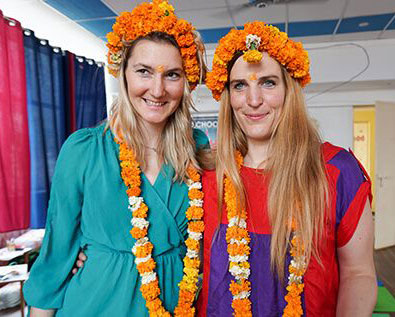 24 days Residential Yoga Course
24 days Residential Yoga Course
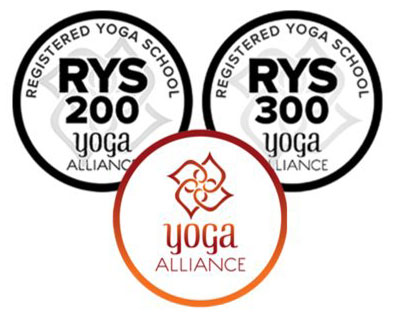 500 hour Yoga Alliance Certification
500 hour Yoga Alliance Certification
 Both Shared / Private Accommodation
Both Shared / Private Accommodation
 Attached Bathroom with Hot water
Attached Bathroom with Hot water
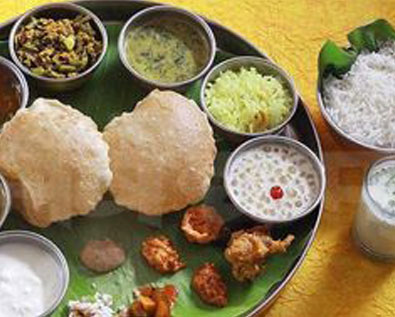 Healthy and Nutritious Meals
Healthy and Nutritious Meals
 Three times Herbal Tea
Three times Herbal Tea
 Filtered Water
Filtered Water
 Free WiFi
Free WiFi
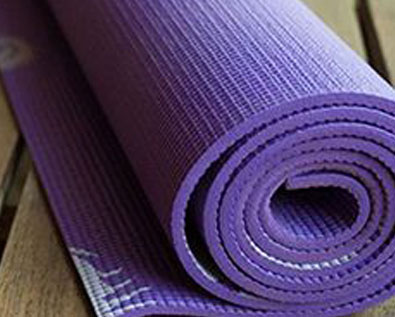 One Yoga Mat
One Yoga Mat
 One Neti Pot
One Neti Pot
 One Rubber Neti
One Rubber Neti
 One Rudraksha Mala
One Rudraksha Mala
 One Yoga Bag
One Yoga Bag
 Course Study Materials
Course Study Materials
 Note Books and Pens
Note Books and Pens
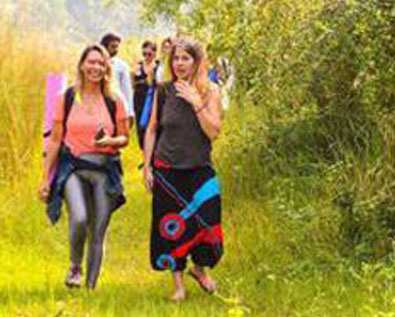 Short Excursion Trip
Short Excursion Trip
 Free Pikc Up from Dehardun Airport
Free Pikc Up from Dehardun Airport
 One Free Ayurvedic Massage
One Free Ayurvedic Massage
Code & Conducts
Read the rules and regulation carefully and obey them during the course
- Discipline is the important part of the training program so the course routine must be strictly followed.
- Please follow all the instructions of the teachers as they all are here to make you grow more.
- Do not leave the class without proper permission of teachers.
- Maintain integrity with other students.
- Do not indulge in alcohol or drugs.
- Smoking is strictly prohibited in the Yoga-School's premises.
- Maintain the safety and cleanliness of the place you will live in.
- Mobile phones, photography and videography are not allowed in the classroom.
- Avoid wearing clothes that expose the body, remember you are in India. Please respect the culture and wear accordingly.
- Always inform the management if you have been suffering from any decrease.
- Always turn off the lights, fans, power plugs, etc., when you are not using them.
- You must inform in advance if they are not taking a meal so that there is no wastage of food.
- For your safety and security, you must come to School before 10 pm at Night.
- Nobody will be allowed to take the meal or tea in the Yoga Hall or in your Room.
Daily Schedule
| Time | Activity |
|---|---|
| 05:30 AM | WAKE UP |
| 06:00 to 06:15 AM | HERBAL TEA AT DINNING HALL |
| 06:15 to 06:30 AM | DAILY YOGIC PURFICATION |
| 06:30 to 07:00 AM | DAILY TRATAK / DAILY OM CHANTING / DAILY GANESH AND GAYATRI MANTRA CHNATING / PRAYER AT YOGA HALL |
| 07:00 AM to 08:00 AM | PRANAYAMA / YOGIC PURIFICATION / BANDHA / MUDRA |
| 08:15 AM to 09:45 AM | HATHA YOGA / ALIGNMENT AND ADJUSTMENT |
| 09:45 AM to 10:30 AM | BREAKFAST AND KARMA YOGA |
| 10:30 AM to 11:30 AM | SPECIAL COURSE OF GRATITUDE FOR PEACE, HAPPINESS AND ALL POSITIVE RESULTS |
| 11:30 AM to 12:30 PM | MANTRA CHANTING/AYURVEDA CLASSES |
| 01:00 NOON to 02:30 PM | LUNCH AND REST |
| 02:30 PM to 03:30 PM | ANATOMY AND PHISIOLOGY / YOGA NIDRA / RELAXATION |
| 03:30 PM to 04:30 PM | PHILOSOPHY DISCOVER YOGA/PATANJALI/CHAKRA/KUNDALINI/SAMADHI |
| 04:30 PM to 04:45 PM | TEA TIME AND SNACKS |
| 04:45 PM to 05:45 PM | MEDITATION / CHAKRA AND KUNDALINI YOGA |
| 05:45 PM to 07:15 PM | ASHTANGA VINYASA / ALIGNMENT AND ADJUSTMENT |
| 07:15 PM to 08:00 PM | DINNER |
| 10:00 PM - | LIGHTS OFF |
*NOTE: This is an overview sample of the daily schedule. The daily schedule provided may vary according to the practice of the practitioner.
500 Hour Yoga TTC Syllabus
200 hours Yoga Teacher Training Course Syllabus
- Prarambhik sthiti (base position) – beginner
- All classified as beginner due to gentle, preparatory nature.
- Padanguli naman (toes movement) – beginner
- Goolf naman (ankles movement) – beginner
- Goolf chakra (ankles movement) – beginner
- Goolf ghooran (ankles movement) – beginner
- Janu naman (knees movement) – beginner
- Janu chakra (knees movement) – beginner
- Mustika bandhana (fingers movement) – beginner
- Manibandha naman (wrists movement) – beginner
- Manibandha chakra (wrists movement) – beginner
- Kehuni naman (elbows movement) – beginner
- Kehuni chakra (elbows movement) – beginner
- Skandha chakra (shoulder rotation) – beginner
- Greeva sanchalana (neck movement) – beginner
- Rajju karshan asana (arm pulling) – beginner
- Chakki chalanasana (torso rotation) – beginner
- Nauka sanchalanasana (rowing – forward bend) – beginner
- Kashtha takshan asana (wood chopping – dynamic) – intermediate
- Gatyatmak meru vakrasana (spinal twist – dynamic) – intermediate
- Kauva chalasana (crawling – quadruped) – beginner
- Marjari asana (spine flexion/extension) – beginner
- Vyaghrasana (tiger pose – dynamic) – intermediate
- Surya namaskara (dynamic flow – solar) – intermediate
- Moon salutation (dynamic flow – lunar) – intermediate
- Sun salutation + variation (dynamic flow – modified) – intermediate
- Sun salutation + breathing (dynamic + breath) – intermediate
- Sun salutation + mantra (dynamic + sound) – intermediate
- Ardha titali asana (hip opener) – beginner
- Poorna titali asana (hip opener) – beginner
- Shroni chakra (hip rotation) – beginner
- Butterfly pose (hip opener) – beginner
- Hanumanasana (front split) – advanced
- Gaumukh asana (hip/shoulder opener) – intermediate
- Namaskarasana (forward squat) – beginner
- Vayu nishkasana (squatting forward bend) – beginner
- Paschimottanasana (seated forward bend) – intermediate
- Janu sirsasana (seated forward bend) – intermediate
- Kurmasana (introspective forward fold) – advanced
- Supta vajrasana (reclining backbend) – beginner
- Ardha ushtrasana (kneeling backbend) – beginner
- Ushtrasana (kneeling backbend) – intermediate
- Sarpasana (prone backbend) – intermediate
- Dhanurasana (bow pose) – intermediate
- Chakrasana (wheel pose) – advanced
- Setu bandhasana (supine backbend) – intermediate
- Supta udarkarshanasana (supine abdominal twist) – beginner
- Shava udarkarshanasana (supine spinal twist) – beginner
- Tiryak bhujangasana (prone twisting backbend) – intermediate
- Udarkarshanasana (twisting squat) – intermediate
- Garudasana (standing balance twist) – advanced
- Vrikshasana (standing balance) – beginner
- Garudasana (twist balance) – advanced
- Bakasana (arm balance forward) – advanced
- Sarvangasana (shoulder-stand) – intermediate
- Halasana (plow pose) – intermediate
- Sirsasana (head-stand) – advanced
- Vrischikasana (scorpion) – advanced
- Padotthanasana (leg raise) – beginner
- Padachakrasana (leg rotation) – beginner
- Pada sanchalanasana (cycling) – beginner
- Supta pawanmuktasana (knee-to-chest) – beginner
- Jhulan lurhakanasana (rocking – digestive) – beginner
- Naukasana (core strength) – intermediate
- Navasana (core strength) – intermediate
- Salabhasana (back strength – prone) – intermediate
- Mayurasana (arm/core balance) – advanced
- Trikonasana (lateral stretch) – beginner
- Bakasana (forward arm balance) – advanced
- Mayurasana (core arm balance) – advanced
- Vajrasana (meditative seat) – beginner
- Sukhasana (cross-leg seat) – beginner
- Ardha padmasana (half lotus pose) – intermediate
- Padmasana (full lotus) – advanced
- Siddhasana (yogic meditative seat) – intermediate
- What is ashtanga (a unique series of asana)
- The importance of ashtanga
- What is vinyasa: movement breathing system
- The importance of ashtanga vinyasa
- Access all areas
- The practice of ashtanga yogasana series
- Surya namaskar a
- Surya namaskar b
- Padangusthasana (big toe pose)
- Padahastasana (hands under feet)
- Trikonasana (triangle)
- Parivrittatrikonasana (revolved triangle)
- Parsvottonasana (side intense stretch)
- Virabhadrasana-i (warrior pose-i)
- Virabhadrasana-ii (warrior pose-ii)
- Utthitaparsvakonasana (extended side angle)
- Parivrittaparsvakonasana (revolved side angle)
- Prasaritapadottanasana (wide leg forward fold)
- Utthita hasta padangusthasana (extended hand to big toe)
- Ardhabaddha padma uttanasana (half bound lotus intense stretch)
- Utkatasana
- Dandasana (staff pose)
- Janu sirsasana (head to knee pose)
- Ardhabaddha padma paschimottanasana (half bound lotus version of paschimottanasana)
- Triangamukaikapada paschimottanasana (1 leg folded back, forward fold)
- Paschimottanasana (west intense stretch)
- Purvottasana (east intense stretch)
- Marichyasana
- Paripurnanavasana (boat)
- Bhujapidasana (arm pressure poses)
- Adhomukhavrksasana (handstand)
- Kurmasana (tortoise)
- Kukkutasana (rooster)
- Garbhapindasana (embryo in the womb)
- Baddhakonasana (bound angle)
- Upavistakonasana (wide-angle seated forward fold)
- Suptakonasana (reclining angle pose)
- Suptapadangustasana (reclining big toe pose)
- Ubhayapadangustasana (both big toes pose)
- Urdvhamukhapaschimottanasana (upward facing paschimo)
- Setubandhasana (bridge-building pose)
- Urdvhadhanurasana (upward bow)
- Paschimottanasana (intense stretch)
- Suptakurmasana (reclining tortoise)
- Savasana (corpse)
- Sirsasana (headstand)
- Balasana (child pose)
- Baddhapadmasana (bound lotus)
- Yogimudrasana (energetic lock or seal)
- Salambasarvangasana (shoulderstand)
- Halasana (plow)
- Karnapidasana (ear pressure)
- Urdvhapadmasana (upward lotus)
- Pindasana in sarvangasana (embryo)
- Matsyasana (fish pose)
- Uttanapadasana (intense stretched feet or legs)
- Padmasana (lotus pose)
- Tolasana (the uplifting - scales)
- Savasana (corpse pose)
- The importance of alignment and adjustment
- What is alignment?
- What is adjustment?
- Five kosha
- Seven chakras
- Nadis
- What is pranayama
- Aspects of pranayama
- The importance of pranayama
- The sequence of pranayama
- Preparation of pranayama
- Different types of pranayama and their precautions
- Introduction of yogic breathing
- Abdominal inhalation
- Thoracic inhalation
- Yogic inhalation
- Inner retention
- Outer retention
- Udgeeth pranayama
- Kapalbhati
- Surya bhedi pranayama
- Chandra bhedi pranayama
- Alternate breathing
- Bhastrika
- Bhamari pranayama
- Ujjayi pranayama
- Seetali
- Seetkari
- Introduction of nadi-sodhanam
- Rules and regulations of pranayama
- Teaching methodology
- Teaching practice
- What is bandha
- Importance of bandha
- Types of bandhas
- Introduction of mool bandha
- Introduction of udiyana bandha
- Introduction of jalandhara bandha
- Introduction of maha bandha
- What is mudra
- Implementation of mudra
- Types of mudras
- Jnana mudra
- Chin mudra
- Bhairav mudra
- Bhairavi mudra
- Nashikagra mudra
- Ashwani mudra
- Introduction of yogic purification (shatkarma)
- Importance of yogic purification
- Jalaneti
- Kapalbhati
- Trataka
- Kunjal kriya
- Sutra neti or rubber neti
- What is relaxation
- The importance of relaxation
- Muscular relaxation
- Deep breathing relaxation
- Tense relax method
- Partial body relaxation
- Full-body relaxation
- Mind relaxation
- What is meditation
- Understanding of meditation
- Understanding of meditation (path of yoga)
- Understanding of meditation (path of knowledge)
- Preparation of meditation
- Practice of meditation
- Practical aspects of meditation
- Om meditation
- Active meditation
- Candle tratak meditation
- Mirror tratak meditation
- Anapana meditation
- Vipassana meditation
- In-active meditation
- Dance meditation
- 5 senses meditation
- Spine awareness
- Spinal breathing meditation
- Introduction of chakra meditation
- Introduction of chakra balancing meditation
- Mudra meditation
- Teaching methodology of meditation
- What is yoga nidra
- The importance of yoga nidra
- Body awareness
- Finding sensation
- Finding blind spot
- Yoga nidra
- The importance of gratitude
- What is gratitude
- The right practice of gratitude
- What is mantra
- What is mantra chanting
- The importance of mantra chanting
- The different kinds of mantra
- Ganesh mantra
- Guru mantra
- Gayatri mantra
- Mahamrityunjaya mantra
- Universal prayer mantra
- Shanti mantra
- Joint movements (flexion, extension, abduction, adduction)
- Joint stabilization
- Joint stability and yoga
- Skeleton system
- Bones
- Types of joints
- Effect of asana on skeleton system
- Types of concentration on the skeleton system
- Major muscles
- Digestive system
- Respiratory system
- Nervous system
- What is philosophy?
- What is the problem
- What is growth
- Introduction of panch kosha
- Panch kosha and its balance
- What is mind?
- Overall about mind
- Balanced mind
- Introduction of Indian philosophy
- Yoga philosophy
- History of yoga
- Different types of yoga
- Raj yoga (patanjali yoga)
- All about patanjali yoga sutra
- Discipline and its importance in yoga
- What is yoga?
- Supportable of yoga
- Obstacles of yoga
- Ashtanga yoga by maharishi patanjali (8 limbs of yoga)
- 1-yama
- 2-niyama
- 3-asana
- 4-pranayama
- 5-pratyahara
- 6-dharana
- 7-dhyana
- Yoga and ethical teaching
- Relation between yoga and yoga alliance
- Relation between personal growth, professional growth, spiritual growth, and yoga
- Yoga ethics related to practice and teaching
- What is professional development?
- Yoga and professional development
- Encourage the trainee to seek RYT
- 200 hours yoga TTC & the profession of yoga (yoga business)
- Continuing the yoga education
- Marketing and promotion
- Support the students for their yoga business and yoga education
- Introduction of ayurveda
- What is ayurveda?
- Fundamentals of ayurveda
- Relation between ayurveda and yoga
- Relation between ayurveda and practical life
- Introduction to 3 dosha
- All about vatta dosha
- All about kapha dosha
- All about pitta dosha
- Body types, body constitution
- Disease and health definition
- Introductions of basic herbs
- What is teaching methodology?
- The importance of teaching methodology
- The fundamental qualities of teaching methodology
- Sequencing
- Pace
- Environment
- Cueing
- Class management
- Classroom preparation
- Classroom organization
- Positive and conscious communication
- Clear instruction
- The tone of the voice
- How much say!
- Be concise
- Offering props
- Passive and active demonstration
- Observation of individual student
- What is practicum
- The importance of the right teaching practice
- Teaching by students
- Support & feedback
- The process of registration
- All about RYT
- All about ERYT
- All about RYS
*Note: The entire syllabus provided over here may vary according to the practicing ability of the practitioner.
300 Hours Yoga Teacher Training Course Syllabus
- Definition of Hatha Yoga (Theoretical)
- Importance of Hatha Yoga (Theoretical)
- Hatha Yoga and Kundalini Asana (Theoretical)
- Joint Movement Series & Warm-up
- Joint Movement Series (Warm-up / Mobility)
- Eye Exercise (Sense Control / Warm-up)
- Beginner Asanas (Preparation for Intermediate and Advanced Kundalini Asana Practice)
- Tadasana (Mountain Pose) - Beginner
- Vrikshasana (Tree Pose) - Beginner
- Marjariasana (Cat-Cow Pose) - Beginner
- Bhujangasana (Cobra Pose) - Beginner
- Setu Bandhasana (Bridge Pose) - Beginner
- Balasana (Child’s Pose) - Beginner
- Sukhasana (Easy Pose) - Beginner
- Ardha Uttanasana - Beginner
- Baddha Konasana - Beginner
- Pawanmuktasana (Wind Release) - Beginner
- Ardha Chandrasana - Intermediate
- Parivrtta Trikonasana - Intermediate
- Virabhadrasana III - Intermediate
- Utkata Konasana - Intermediate
- Parivrtta Ardha Chandrasana - Advanced
- Skandasana - Intermediate
- Ardha Baddha Padma Paschimottanasana - Intermediate
- Triang Mukhaikapada Paschimottanasana - Intermediate
- Kurmasana - Advanced
- Hanumanasana - Advanced
- Agnistambhasana - Intermediate
- Krounchasana - Advanced
- Bharadvajasana II - Intermediate
- Ardha Matsyendrasana - Intermediate
- Parivrtta Janu Sirsasana - Intermediate
- Marichyasana III - Advanced
- Lolasana - Advanced
- Tittibhasana - Advanced
- Bakasana - Intermediate
- Eka Pada Koundinyasana - Advanced
- Astavakrasana - Advanced
- Mayurasana - Advanced
- Ustrasana - Intermediate
- Kapotasana - Advanced
- Eka Pada Rajakapotasana I - Advanced
- Dhanurasana - Intermediate
- Urdhva Dhanurasana - Advanced
- Viparita Dandasana - Advanced
- Sirsasana - Intermediate
- Pincha Mayurasana - Advanced
- Adho Mukha Vrksasana - Advanced
- Viparita Karani - Intermediate
- Eka Pada Sirsasana - Advanced
- Karnapidasana - Intermediate
- Vasisthasana - Intermediate
- Utthita Hasta Padangusthasana - Intermediate
- Ardha Baddha Padmottanasana - Intermediate
- Garudasana - Intermediate
- Natarajasana - Advanced
- Padmasana - Intermediate
- Baddha Padmasana - Advanced
- Yoga Mudrasana (in Padmasana) - Intermediate
- Siddhasana - Intermediate
- Muktasana - Intermediate
- Bhujapidasana - Advanced
- Yoganidrasana - Advanced
- Supta Kurmasana - Advanced
- Kasyapasana - Advanced
- Gandha Bherundasana - Advanced
- Chakorasana (or Purna Chakrasana) - Advanced
- Sun Salutation A
- Sun Salutation B
- Utthita Trikonasana - Triangle Pose
- Utthita Parvakonasana - Extended Side Angle Pose
- Parivrtta Trikonasana - Revolved Triangle
- Parivritta Parsvakonasana – Revolved Side Angle Pose
- Padangusthasana - Big Toe Posture
- Utthita Hasta Padangusthasana - Hand to Big Toe Posture
- Padahastasana – Hands Under Feet Posture
- Prasarita Padottanasana A to D – Intense Wide Leg Stretch
- Ardha Baddha Padmottanasana - Half-Bound Lotus Forward Bend
- Urdhva Mukha Paschimottanasana - Upward Facing Full Forward Bend
- Purvottanasana – Intense East Stretch
- Paschimottanasana – Full Forward Bend
- Navasana – Boat Posture
- Bhujapidasana - Shoulder Pressure Posture
- Garbha Pindasana - Embryo Posture
- Kurmasana - Tortoise Posture
- Supta Kurmasana - Sleeping Tortoise
- Baddha Konasana A to B – Bound Angle Posture
- Supta Konasana A to B – Lying Down Angle Posture
- Upavista Konasana A to B - Seated Angle Posture
- Marichyasana A, B, C
- Kukkutasana – Rooster Posture
- Setu Bandhasana - Bridge
- Urdhva Dhanurasana - Upward Bow Posture
- Sarvangasana – Shoulder-Stand
- Urdhva Padmasana – Upward Lotus
- Karnapidasana – Ear Pressure Posture
- Halasana – Plow
- Matsyasana – Fish Posture
- Supta Padangustasana – Reclining Big Toe Posture
- Ubhaya Padangusthasana - Both Big Toes Postures
- Uttana Padasana - Extended Leg Posture
- Sirsasana – Headstand
- Padmasana – Lotus
- Yoga Mudra - Sealed Yoga Posture
- Balasana – Relaxation Pose
- The Importance of Alignment and Adjustment
- What is Alignment?
- What is Adjustment?
- Five Kosha
- Seven Chakras
- Nadis
- What is Pranayama
- Aspects of Pranayama
- The Importance of Pranayama
- The Sequence of Pranayama
- Preparation of Pranayama
- Different Types of Pranayama and Their Precautions
- Introduction of Yogic Breathing
- Right Practice of Yogic Inhalation
- Right Practice of Yogic Exhalation
- Right Practice of Yogic Breathing
- Inner Retention
- Outer Retention
- Udgeeth Pranayama
- Right Practice of Kapalbhati with Lock
- Surya Bhedi Pranayama
- Chandra Bhedi Pranayama
- Alternate Breathing
- Bhastrika
- Bhramari Pranayama
- Ujjayi Pranayama
- Sheetali
- Sheetkari
- The Right Practice of Nadi-Shodhanam
- Rules and Regulations of Pranayama
- Teaching Methodology
- Teaching Practice
- What is Bandha
- Importance of Bandha
- Types of Bandhas
- Right Practice of Mool Bandha
- Right Practice of Udiyana Bandha
- Right Practice of Jalandhara Bandha
- Right Practice of Maha Bandha
- Mudras can be categorized into five different groups:
- Hand Mudra
- Head Mudra
- Postural Mudra
- Lock Mudra
- Perineal Mudra
- What is Mudra
- Implementation of Mudra in Mantra Chanting and Meditation
- Types of Mudras
- Hand Mudra:
- Jnana Mudra
- Chin Mudra
- Bhairava Mudra
- Bhairavi Mudra
- Head Mudra:
- Nasikagra Mudra
- Shambhavi Mudra
- Kaki Mudra
- Boochari Mudra
- Akashi Mudra
- Postural Mudra:
- Yoga Mudra
- Viparati Karani Mudra
- Prana Mudra
- Lock Mudra:
- Maha Mudra
- Mahavheda Mudra
- Perineal Mudra:
- Ashwini Mudra
- Introduction to Yogic Purification (Shatkarma)
- Importance of Yogic Purification
- Precautions of Yogic Purification
- Jalaneti
- Kapalbhati
- Trataka
- Kunjal Kriya
- Sutra Neti or Rubber Neti
- Agnisaara Kriya
- What is Relaxation
- The Importance of Relaxation
- Muscular Relaxation
- Deep Breathing Relaxation
- Tense Relax Method
- Partial Body Relaxation
- Full-Body Relaxation
- Mind Relaxation
- What is Meditation
- Understanding of Meditation
- Understanding of Meditation (Path of Yoga)
- Understanding of Meditation (Path of Knowledge)
- Preparation of Meditation
- Practice of Meditation
- Practical Aspects of Meditation
- Om Meditation
- Active Meditation
- Candle Tratak Meditation
- Mirror Tratak Meditation
- Anapana Meditation
- Vipassana Meditation
- In-active Meditation
- Dance Meditation
- 5 Senses Meditation
- Spine Awareness
- Spinal Breathing Meditation
- Introduction of Chakra Meditation
- Introduction of Chakra Balancing Meditation
- Chakra Meditation
- Kundalini Meditation
- Mudra Meditation
- Teaching Methodology of Meditation
- What is Yoga Nidra
- The Importance of Yoga Nidra
- Body Awareness
- Finding Sensation
- Finding Blind Spot
- Yoga Nidra
- The Importance of Gratitude
- What is Gratitude
- The Right Practice of Gratitude
- What is Mantra
- What is Mantra Chanting
- The Importance of Mantra Chanting
- Ganesha Mantra
- Guru Mantra
- Gayatri Mantra
- Maha-Mantra
- Maha Mrityunjay Mantra
- Universal Prayer Mantra
- Shanti Mantra
- Joint Movements (Flexion, Extension, Abduction, Adduction)
- Joint Stabilization
- Joint Stability and Yoga
- Skeleton System
- Bones
- Types of Joints
- Major Muscles
- Effect of Asana on Skeleton System
- Types of Concentration on the Skeleton System
- Cardiovascular System
- Endocrine System
- Digestive System
- Respiratory System
- Nervous System
- What is Philosophy?
- What is Growth?
- What is a Problem?
- What is a Complaint?
- Introduction of Panch Kosha
- What is Mind?
- The Nature of the Mind
- Working Area of the Mind
- Goal and Mind
- Importance of Goal
- How to Set a Goal
- Gratefulness and Mind
- The Importance of Gratefulness
- Symptoms of the Balanced Mind
- Introduction of Indian Philosophy
- Different Types of Yoga
- Introduction of Raja Yoga (Patanjali Yoga)
- What is Yoga?
- Discipline and its Importance in Yoga
- Experience of Thoughtlessness
- What is Samadhi?
- Supportable of Yoga
- Obstacles of Yoga
- Surrender
- Concept of God
- Introduction of Ashtanga Yoga of Patanjali
- Introduction of the Five Kleshas
- Ignorance
- Ego
- Attachment
- Aversion
- Fear
- Right Understanding of Kundalini Yoga
- Yoga and Ethical Teaching
- Relation Between Yoga and Yoga Alliance
- Relation Between Personal Growth, Professional Growth, and Spiritual Growth in Yoga
- Yoga Ethics Related to Practice and Teaching
- What is Professional Development?
- Yoga and Professional Development
- Encourage the Trainee to Seek RYT
- 300 Hours Yoga TTC & the Profession of Yoga (Yoga Business)
- Continuing Yoga Education
- Marketing and Promotion
- Support the Students for Their Yoga Business and Yoga Education
- Introduction to Ayurveda
- What is Ayurveda?
- Fundamentals of Ayurveda
- Relation Between Ayurveda and Yoga
- Relation Between Ayurveda and Practical Life
- Introduction to 3 Doshas
- All about Vatta Dosha
- All about Kapha Dosha
- All about Pitta Dosha
- Body Types, Body Constitution
- Disease and Health Definition
- Introductions of Basic Herbs
- What is Teaching Methodology?
- The Importance of Teaching Methodology
- The Fundamental Qualities of Teaching Methodology
- Sequencing
- Pace
- Environment
- Cueing
- Class Management
- Classroom Preparation
- Classroom Organization
- Positive and Conscious Communication
- Clear Instruction
- The Tone of the Voice
- How Much to Say!
- Be Concise
- Offering Props
- Passive and Active Demonstration
- Observation of Individual Student
- What is Practicum
- The Importance of the Right Teaching Practice
- Teaching by Students
- Support & Feedback
- The Process of Registration
- All About RYT
- All About ERYT
- All About RYS
*Note: The entire syllabus provided over here may vary according to practice of the practitioner.
Food & Accommodation
Food
Eating can also be considered proper nutrition in which you seek universal balance. You have to develop mindful eating practice can provide a ground that truly supports your personality & Yoga practice.
Three-time (Breakfast, Lunch & Dinner) meals per day.
All Meals are a vegetarian, nutritious, healthy and balanced diet.
A nourishing diet with fruits, vegetables, Indian herbs are added to the meal plan on an everyday basis.
Two times Tea during the course.


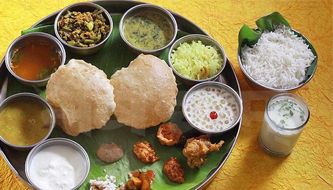
Accommodation
We offer Single Private and shared rooms.
The rooms have the facilities to suit the western lifestyle and we strive to make improvements according to comfortable staying.
Each room is arranged with a study table, chair, Double bed, and a storage closet to store your belongings.
We provide fresh pillow covers and bedsheet once a week.
Every room equipped with a nicely made washroom with all facilities like Toilet paper, Disposable bin, western toilet, washbasin to suit the western lifestyle.
The washroom are facilities with 24 hours hot & normal water.

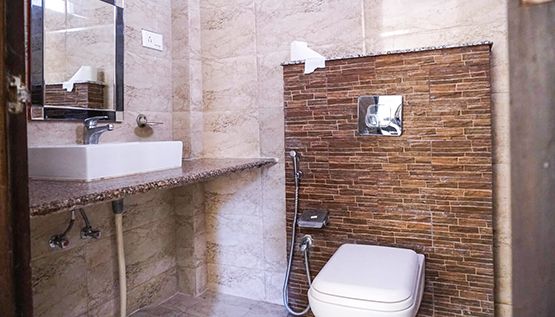
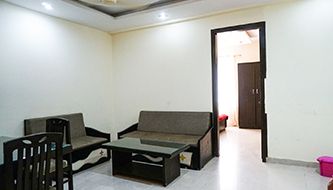
Our Yoga Course Benefits
- Learn Hatha-Yoga to deal with your mind and energy.
- Work with your Chakra through Hatha-Yoga.
- Practice more Nadi-Sodhana Pranayama, the only Pranayama in Indian traditional yogic system.
- Learn Pranayama for the Kundalini awakening.
- Get Pranayam sequence and schedule for your self-practice.
- Get proper knowledge about yogic gesture (mudra) and its practical use during yoga practice.
- Learn more Yoga Mudras from traditional yogic scriptures.
- Get personal attention to learn and practice yogic locks (Bandhas).
- Dissolve your knots, if you have by practicing different Yogic Locks and Pranayama.
- Learn the right techniques to develop a meditation technique yourself.
- Understand the meditation as a happening not as a practice.
- Learn the art of relaxation.
- Know the right technique to instant relax.
- Get the right techniques to designer short Yog -nidra methods for practical use.
- Arrange your subconscious mind by Yoga-nidra.
- Protect All negativities by Mantra Chanting.
- Discover the source of Intelligence
Frequently Asked Questions
Siddhant School of Yoga, one of authentic and result oriented yoga school in Rishikesh, India. We are providing high-quality yoga education and curriculum following the standards of Yoga Alliance USA.
Our 200-hour and 300-hour Yoga Teacher Training Course are certified by Yoga Alliance USA. We are providing a 500-hour Yoga TTC as it is a combination of 500 hours and 300 hours Yoga Program. After certification from Siddhant School of Yoga, you will be eligible to teach throughout the world as a Yoga teacher.
Note: After certification, you need to register yourself at Yoga Alliance to become an officially Registered Yoga Teacher (RYT)according to Yoga Alliance USA. The Yoga Alliance will charge almost $115 as the registration fees to register yourself as a yoga teacher. For your kind information more than 70000 Registered Yoga Teacher (RYT) and more than 30000 Registered Yoga Schools (RYS) you can find in Yoga Alliance family. So come be a part of a big and beautiful family of Yoga. For more information please visit www.yogaalliance.com.
The 'Right Attitude' is the only eligibility criteria to participate in a yoga course. If you have the right attitude, definitely you can join a yoga course and get the benefit for your growth. Besides this basic eligibility, you need to have some more practical eligibility to attend any kind of yoga program at Siddhant School of Yoga.
- 1- The applicant should be in a good physical condition.
- 2- Need to be open-mind and eagerness to understand and practice Yoga.
- 3- Dedication to practice 9 to10 hours daily with 100% attendance.
- 4- You must be a vegetarian during the yoga course.
- 5- Alcohol, drugs, and smoking are must not be allowed during the yoga course.
- 6- Need to know basic English.
- 7- Age group in-between 18 to 60 years.
- 8- Must not have any surgery for last one year.
- 9- Not allowed with any kids.
All these basic points are the eligibility criteria of yoga courses provided by Siddhant School of Yoga is really help you to understand and practice Yoga for your growth and success. Please go through all these points carefully before join a yoga course.
1. Two (2) color photocopy of your Passport are required, it should be very clear. Please be aware, you need to show the original Passport to us.
2. Two (2) color passport size photo is required, it should be very clear.
We need to know your Visa expiry date, as you got before arrival.
Let you remind that you are required an Indian Tourist Visa before traveling to India.
To arrival in India, you as a foreigner need a Visa. Give yourself some amount of time to arrange an Indian Tourist Visa from the Indian embassy or through the Visa services company before leaving your country and traveling to India. Please arrange your health and travel insurance and other important requirements like bank and credit card issues before leaving your home town and country.
You are most welcome to Siddhant School of Yoga. You can come to stay before one day, the starting date of the yoga course. Upon your arrival in our yoga school, you will provide your room to take rest and fresh. After some rest please come to the office and fill-up your course application form and deposit the rest of your course fees. Then you will get the current day and next day schedule and we will show all the areas, you are going to use throughout the yoga program, like Yoga Hall, Dining, etc.
On the starting day of the yoga course, you will provide a Hatha-Yoga class in the morning at 8:00 am to 9:00 am then you will have your breakfast. At 10:30 a.m. our fire-ceremony program, the traditional way to start any program in India. After that, we will take a group photo for your good memory and for official use and just after that, you will get your study-materials for your yoga TTC and then Lunch and rest.
At 3:00 pm, the starting day of the yoga course, we are conducting an orientation class to let you know all about the yoga course. Such as About teachers, syllabus, rule and regulations, food, accommodation, benefits, the right way to go through the Yoga course and many other things looking to the success of this Yoga Course.
In this orientation meeting, the students meet each other and get introduced the teachers to our new students. Here you will be asked about your expectations and goals so that we can help you accordingly during the yoga course. You can ask anything, whatever you want more or want to know about more in this Yoga Course, definitely, we will try our best to cooperate and provide to you. In this orientation session, you will get the 1st-week yoga course schedule and then after, the Yoga course starts officially along with the Ashtanga Yoga class in the evening.
You are most welcome to our school. We are providing everything to you related to Yoga education, food, and accommodation. We are here to help and serve you as a friend and family but it will be better to bring some useful things to help you and will be comfortable and convenient for you during yoga course.
You can bring your tablets, cameras, laptops and any other electronics products you are using for your easy and growing life. You should bring 2(two) passport size photographs for our record and certificate, mobile phone, cords of the electronic devices, ATM Debit Card (for the best exchange rate) clothes suits the seasons, comfortable clothes for practicing yoga, shoes, travel towel, first aid kit and basic medications and any personal belongings item. You may bring the musical instrument, mp3 player or anything else that you thinks is necessary. Please do not brings those things which are not useful and necessary during the travel or Yoga course, such as expensive jewelry and ornaments. If you bring, please be aware of your things and keep them safe. We are not responsible if any theft happens over here. However, Siddhant School of Yoga gives priority to your safety.
Course Registration
As you express you’re willing about doing yoga and ready to do
- First Send your inquiry to us.
- Our team send you a presentation of our yoga course as soon as we get your inquiry.
- Submit your Rregistration form below and pay $500 as registration fee which is non-refundable.
- Then finally we send you a confirmation email to you about confirm your booking.
Click the button below for quick registration.
If you have any query then feel free to contact us anytime. We are always there to assist you!
Course Fee: Shared Room : USD 2299 Private Room : USD 2599
Registration Fee: 500 USD
Refund Policy
All the students are advised to read the policy carefully before forwarding the application and the payment for the yoga teacher training course.
- The advance deposited for the course is non-refundable.
- In case of Emergency and unavoidable situation, students can postpone the course and go for any other month’s scheduled course within the current year. Students must inform us by the email with proper reason to postpone the course.
- If students cancel the course, we accept the cancelation but the advanced amount is non-refundable. There are no charges for cancellation but students have to inform us about the cancellation by email.
What's Our Students Say

Video Review


Understand your true indentity
This point is specially mentioned for a seeking attitude yoga practitioner. Actually, yoga is meant for you to find...

Measure your growth Step by Step
Learning and practicing yoga exactly one of the best steps towards a great life but are you aware of your practice weather is it on...

Result Oriented Yoga School
Siddhant School of Yoga Is a result oriented Yoga School in Rishikesh India. We are presenting YOGA as a science, if you practice ...

